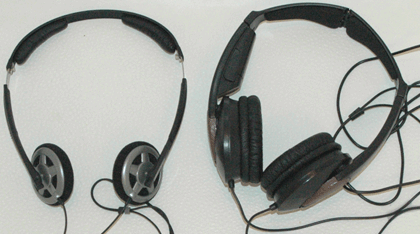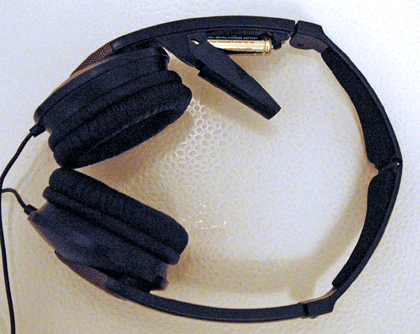Hardware review
Headphones
Noisebuster ProTech NB-FX

Developer: Pro Tech Communications
Price: $69 (list)
Requirements: iPod, stereo, Walkman, etc.
Trial: None
Technical Specifications: 20Hz–20KHz frequency response, unknown THD.
Sennheiser PX100

Developer: Sennheiser
Price: $60 (list); $50 (street)
Requirements: iPod, stereo, Walkman, etc.
Trial: None
Technical Specifications: 15Hz–27KHz frequency response, 0.1% THD.
One of the more amusing aspects of most mainstream iPod reviews is the lack of concern for sound quality, even though most people buy the things to listen to music. Most reviews, indeed, can be summarized as “the iPod wins on style but other players have more features and better battery life.” The anti-iPod people, most of whom are admittedly working for publications partly owned by Microsoft, downplay the style and emphasize the other features (most of which are rarely, if ever, used—why would I buy a $299 voice recorder when I can get a better one for $30?). But very rarely is the music itself put front and center.
One reason for this is the role of headphones and earbuds—without the standard headphones, the players probably all sound pretty much the same. Apple’s standard buds are not the stuff legends are made of, though they are certainly decent by the standards of original-equipment earbuds. But if you try out an iPod with audiophile headphones or hook it up to a stereo, there’s a clear difference between the iPod and competitors, according to most reviewers who have done this. Indeed, the little iPod shuffle actually turns out to have the most accurate sound reproduction of just about any digital player—and, for what it’s worth, similar-rate AAC nearly always beats MP3. (I tend to record at the maximum bitrate for higher quality, but it’s probably not necessary.)
Most reviewers seem to focus on the excellent range of sound-deadening headphones that turn away the outside world. That makes sense for those who listen on airplanes, buses, and other noisy environments, but what if you work in an office—say, a home office—and need to be able to clearly hear the doorbell, telephone, or a spouse? Then you’d want open-air headphones, which let in the sounds around you. That’s where the Sennheisers beat the Shures and Noisebusters; though on an airplane or lawnmower, you’d almost certainly leave the Sennheisers in their case.

Sennheiser PX100 (left) and Noisebuster ProTech NB-FX
The Sennheiser PX100 headphones seem to hit a sweet spot in value and convenience. As with most Sennheisers, they are relatively comfortable; they don’t feel as though they are designed to mold to your ears (the contact patch is flat), but they don’t hurt when you wear them for hours at a time, as my venerable Sony MDR-V6 conventional-style studio headphones (cost: $100 circa 1990) do. The two sides are clearly marked (left and right), and they have adjustments for different sized heads. They were comfortable on my big head and on my nine-year-old’s little head.
The PX100 sells for between $40 and $60 at most outlets, which is well within the “reasonable” range, and far from audiophile price tags. Despite this, the sound is quite good, with bass slightly emphasized but with good overall clarity and accuracy. If you really want booming bass, the open-air headphone style probably isn’t ideal, especially coupled to the iPod shuffle, which seems to have a weak output. The PX100 is efficient enough to manage dangerously high volumes from the Shuffle without distortion. It also works well with standard stereo equipment, including full-sized receivers and little portable CD players. The frequency range is fairly generous, and clarity and balance are good enough to make listening at low volumes a pleasure—no need to crank it though, again, if you’re into heavy bass, you may want to equalize the music. Though audiophiles criticize the PX100 for emphasizing bass, many rockers will find the opposite is true.
It may be nice to have balance, volume, or equalizer controls, but these are fairly rare on headphones anyway, and take away one frequent source of failure (knobs or, as the experts call ’em, pots—potentiometers).
For convenience, the PX100 folds up into a small, hard case with a wire wrap; that is, if you have the time and manual dexterity. If you don’t travel with it, you’ll probably prefer to leave it on a hook instead. I found it rather difficult to put back into the case, despite the instructions on the box (the best place to put them), but that’s probably a skill that builds with time. For air travel, I leave the PX100 at home and take along active sound-deadening headphones instead—they’re not comfortable and don’t have great sound quality, but they do take away the airplane drone.

Folded Sennheiser PX100 (left) and Noisebuster ProTech NB-FX
Speaking of the sound-deadening headphones, I also tested out a set of Noisebuster ProTech NB-FX noise canceling headphones that are actually not bad for sound quality. They’re just not in the same league as the Sennheisers, nor are they designed for the same purpose. The goal of the Noiesbuster is to block out external droning sounds; it works fairly well at lowering the sound of the omnipresent suburban landscapers, and very well at bringing commuter jets down to reasonable levels. At the same time, unsteady sounds such as telephones make it right on through. The down-side is a lack of comfort after a half-hour’s use, which is partly due to the general sealed-over-the-ear design, which was once almost omnipresent; and foggy, lackluster music quality. They fold twice for easy storage, and while the leather bag they come with doesn’t provide any real protection, I’ve carried them back and forth on a few jets without much protection and also without any damage.

Noisebuster ProTech NB-FX Battery Compartment
The Noisebuster, incidentally, is powered by a single, long-lasting AAA cell, which installs easily into the structure, and senses ambient noise through microphones on each side; it seems to automatically set up separate left and right channel noise canceling waves. While I found them a bit tight, those with smaller heads (insert joke here) may well find them to be very comfortable. The cord is well anchored, which bodes well for longevity—the only headphone breakage I’ve experienced in 25 years of ownership has been to the cord—and a good quality mini-to-full-size headphone jack is included for use with full sized stereos. The Noisebuster works well with a variety of signal strengths and is efficient enough to be easily driven by the Shuffle. The top of the Noisebuster headset is padded, so there’s no rough spot on the user’s head; my main comfort issue was pressure against the ears, and there the Noisebuster is, to be fair, no worse than my venerable and once-beloved Sony MDR-V6.
In flight or other noisy situations, an open-air set like the Sennheisers is definitely not a good idea; to hear the music properly, you’d need to jack up the volume, and that’s not so good for the ears. Blocking out the noise, either physically as with the highly-reviewed but expensive Shures (and many others), or electronically as with the Noisebusters (and many others), is called for instead.
But back to the PX100. While very light, the headphones seem to be tough as well, and not especially prone to easy breakage. The cord appears to be well anchored, and the length is reasonable—not too long for listening to a Shuffle, not too short for listening to your computer or stereo. A high quality mini-to-full-sized adapter is provided with the unit. The hardest thing about owning these headphones is spelling “Sennheiser.”
The generally favorable qualities of the Sennheisers should be no surprise to those who have been around audio equipment for the last few decades; they were the leading open-air headphones back in the 1980s and probably long before, as well. Before the Sony Walkman made open-air headphones popular, Sennheiser was selling them for full-sized receivers. The PX100 is not the most convenient set of headphones, nor the best sounding, nor the most comfortable, nor the cheapest; but it does provide a balance of these qualities, which makes it an excellent value.
Reader Comments (6)
erik_tilton@yahoo.com
I have to agree with your assessment -- I like my Sennheiser's quite a lot. They are the best open-air headphones I've personally owned. Sound quality seems quite balanced, at least to my ears. Quality of the unit also seems quite good, which is consistent with my earlier experience with Sennheiser products.
I'm thinking about popping for a set of the Shure earbuds, but they're expensive at a list price of about $500. I've never owned a really high quality set of headphones, but think I would, particularly now that I'm flying more.
Good review! Thanks!
Add A Comment